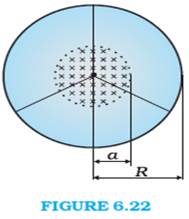A line charge λ per unit length is lodged uniformly onto the rim of a wheel of mass M and radius R. The wheel has light non - conducting spokes and is free to rotate without friction about its axis (Fig. 6.22). A uniform magnetic field extends over a circular region within the rim. It is given by,
B = – B0 k (r ≤ a; a < R)
= 0 (otherwise)
What is the angular velocity of the wheel after the field is suddenly switched off?

Line charge per unit length is given by the following relation:
Total charge/ length = Q/2π r
Where r is the distance of the point within the wheel
Let m and R are mass and radius of the wheel
Magnetic field is given by the following relation:
![]()
The magnetic force at balanced by the centripetal force at a distance of r
i.e. BQv = mv2/r
v is the linear velocity of the wheel and is equal to v= 2π rλ
⇒ B × 2π rλ = mv/r
Or ![]()
As we know that angular velocity is given as: ω = v/r
⇒ w = ![]()
When R> a and r ≤ a
ω = ![]()